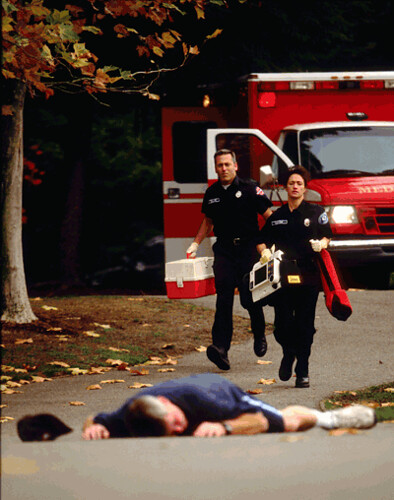


Cameron Health, Inc. announced the publication of study results online in the New England Journal of Medicine (NEJM) highlighting the development and potential benefits of the company's S-ICD[R] System, the first minimally invasive, subcutaneous implantable cardioverter defibrillator (ICD), for the treatment of sudden cardiac arrest (SCA). In the studies, the S-ICD detected 100 percent of induced and spontaneous episodes of irregular heart rhythms. This publication represents nine years of development and clinical work with 17 medical centers in seven countries.
The S-ICD System is unique in that its implantation is entirely subcutaneous (under the skin), eliminating the need for lead placement in or on the heart and simplifying the surgery by eliminating the need for imaging equipment. Transvenous ICD's require placement of at least one lead in or on the heart. Most frequently, these leads are threaded through a vein and placed inside the heart, allowing for sensing of the heart's rhythm and delivery of a life-saving electric shock when a harmful arrhythmia is detected. The surgical placement and ongoing presence of these transvenous leads within the patient's heart are associated with a significant proportion of the complications related to this well established and highly effective therapy.
"Transvenous implantable cardioverter defibrillators have proven to be an effective therapy for treating sudden cardiac arrest, a leading cause of death in the United States. As with any medical technology, however, there is room for improvement," said Gust H. Bardy, M.D. of the Seattle Institute for Cardiac Research, lead author of the NEJM paper and co-founder of Cameron Health. "These studies suggest that the S-ICD System is a viable alternative that may overcome some of the problems associated with transvenous ICDs in certain patients. The findings suggest that physicians now have an important new option to consider when evaluating patients for defibrillator therapy, and one that may reduce the barriers to adoption of this life-saving therapy."
The NEJM publication highlights four studies of the S-ICD System. Two short-term trials designed to identify a suitable device configuration and assess energy requirements were followed by two longer-term trials designed to assess the efficacy of the S-ICD System in detecting and treating ventricular fibrillation and ventricular tachyarrhythmias. The trials were conducted between September 2001 and November 2009. Results of the longer-term studies include 100 percent detection of induced arrhythmias and 98 percent conversion success for patients implanted with the S-ICD System. In addition, ventricular tachyarrhythmias were detected and treated in 100 percent of 12 spontaneous episodes.
"Cameron Health's goal in developing the S-ICD System was to significantly improve upon current ICD therapy by reducing the complications associated with transvenous leads, as well as to simplify implantation, programming and follow-up," said Kevin Hykes, President and Chief Executive Officer, Cameron Health, Inc. "The publication of these data is a clear acknowledgement of the important pioneering contributions made by the clinical investigators. We believe that the S-ICD System has the capability to significantly lower adoption barriers, increase patient acceptance and ultimately save more lives."
Clinical Trial Design In the first of the short-term trials, four subcutaneous ICD configurations were evaluated in 78 patients who were candidates for ICD implantation. In the second of the short-term trials, the optimal configuration was then tested in 49 additional patients to determine the subcutaneous defibrillation threshold in comparison to the standard transvenous ICD. The optimal device configuration was as effective as a transvenous ICD but required a significantly higher energy requirement (36.6+/-19.8 joules vs. 11.1+/-8.5 joules). Long-term implants were evaluated in a six-patient pilot study followed by a 55-patient single-arm trial. In the pilot study, a total of 18 episodes of ventricular fibrillation were induced, all of which were appropriately detected, and all sustained episodes of ventricular fibrillation were successfully converted. In the 55-patient single-arm trial, all episodes of sustained ventricular fibrillation were appropriately detected, and 98% of patients satisfied implant testing criteria.
Keywords: Cardiac Arrest, Cardiac Arrhythmias, Cardiology, Cardiovascular, Clinical Trial Research, Defibrillator, Heart Diseases, Medical Device, Ventricular Fibrillation, Edelman Public Relations.
This article was prepared by NewsRx Health editors from staff and other reports. Copyright 2010, NewsRx Health via NewsRx.com.
Source Citation
"Research published in NEJM highlights potential benefits of Cameron Health's S-ICD System." NewsRx Health 30 May 2010: 68. Health Reference Center Academic. Web. 7 June 2010.
Document URL
http://find.galegroup.com/gps/infomark.do?&contentSet=IAC-Documents&type=retrieve&tabID=T003&prodId=IPS&docId=A226919147&source=gale&srcprod=HRCA&userGroupName=18551_mcpls&version=1.0
Gale Document Number:A226919147
Disclaimer:This information is not a tool for self-diagnosis or a substitute for professional care.


No comments:
Post a Comment